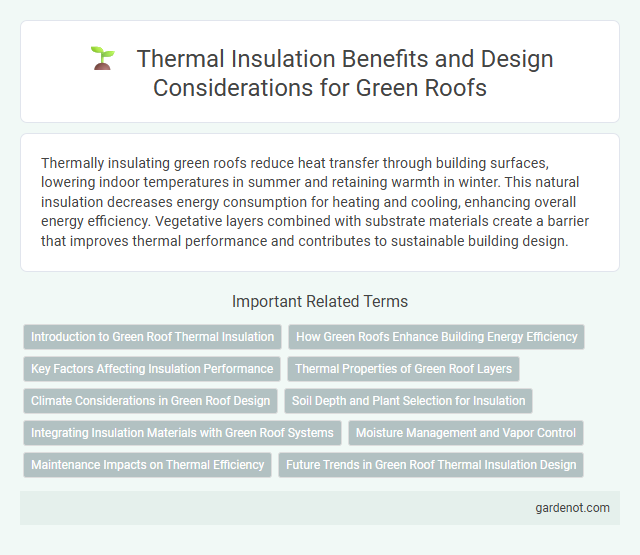Thermally insulating green roofs reduce heat transfer through building surfaces, lowering indoor temperatures in summer and retaining warmth in winter. This natural insulation decreases energy consumption for heating and cooling, enhancing overall energy efficiency. Vegetative layers combined with substrate materials create a barrier that improves thermal performance and contributes to sustainable building design.
Introduction to Green Roof Thermal Insulation
Thermally insulating green roofs enhance building energy efficiency by reducing heat transfer through the roof structure. Vegetative layers combined with specialized insulation materials create a natural barrier that stabilizes indoor temperatures and lowers heating and cooling demands. Incorporating thermal insulation in green roof systems significantly contributes to sustainable building design and energy conservation.
How Green Roofs Enhance Building Energy Efficiency
Green roofs provide exceptional thermal insulation by reducing heat transfer through the building envelope, lowering indoor temperatures during summer and retaining warmth in winter. The layered vegetation and soil function as natural insulators, decreasing the need for mechanical heating and cooling systems, which leads to significant energy savings. Research shows that green roofs can reduce urban heat island effect and improve overall building energy efficiency by up to 25%.
Key Factors Affecting Insulation Performance
Thermally insulating green roofs rely on several key factors affecting insulation performance, including the type and thickness of the growing medium, which directly influences thermal resistance and moisture retention. Vegetation density and species selection impact shading and evapotranspiration rates, reducing heat transfer through the roof structure. Proper waterproofing and drainage layers are essential to prevent water accumulation that can degrade insulation efficiency and cause thermal bridging.
Thermal Properties of Green Roof Layers
Thermally insulating green roofs consist of multiple layers including vegetation, substrate, drainage, and insulation, each contributing distinct thermal properties that reduce heat transfer and enhance energy efficiency. The substrate layer acts as a thermal mass, absorbing and slowly releasing heat, while the insulation layer minimizes conductive heat loss, maintaining stable indoor temperatures. Vegetation provides shading and evapotranspiration cooling effects, significantly lowering surface temperatures and reducing the urban heat island effect.
Climate Considerations in Green Roof Design
Thermally insulating green roofs significantly reduce urban heat island effects by enhancing building energy efficiency through natural temperature regulation. Climate considerations such as local temperature fluctuations, solar radiation intensity, and precipitation patterns directly influence the selection of plant species and substrate depth to optimize thermal performance. Incorporating regional climatic data into design ensures the green roof maintains effective insulation year-round, minimizing heating and cooling demands.
Soil Depth and Plant Selection for Insulation
Thermally insulating green roofs rely heavily on soil depth and plant selection to maximize energy efficiency. Deeper soil layers enhance thermal mass, reducing heat transfer and maintaining stable indoor temperatures while supporting diverse vegetation like sedums and native perennials that provide optimal insulation. Selecting drought-resistant, low-maintenance plants further improves the roof's insulating performance and longevity in various climates.
Integrating Insulation Materials with Green Roof Systems
Integrating insulation materials with green roof systems enhances thermal performance by reducing heat transfer through the roof structure, leading to improved energy efficiency in buildings. Common insulation materials include extruded polystyrene (XPS) and expanded polystyrene (EPS), which provide high compressive strength and moisture resistance essential for green roof durability. Proper installation ensures that the insulation layer works synergistically with vegetation and growing medium to maintain stable indoor temperatures and decrease heating and cooling costs.
Moisture Management and Vapor Control
Thermally insulating green roofs enhance energy efficiency by incorporating moisture management systems that prevent water accumulation and reduce thermal bridging. Advanced vapor control layers regulate the passage of moisture vapor, mitigating the risk of condensation and structural damage. These features collectively improve the roof's durability and maintain stable indoor temperatures, optimizing overall thermal performance.
Maintenance Impacts on Thermal Efficiency
Thermally insulating green roofs significantly reduce heat loss and improve building energy efficiency by providing a natural barrier against temperature fluctuations. Maintenance activities such as irrigation, pruning, and replacing plants influence the thermal performance by ensuring the vegetation remains healthy and dense, which enhances insulation properties. Neglecting maintenance can lead to soil compaction and vegetation thinning, decreasing the roof's thermal resistance and overall energy-saving benefits.
Future Trends in Green Roof Thermal Insulation Design
Advancements in thermally insulating green roofs emphasize the integration of high-performance insulation materials such as aerogels and phase change materials (PCMs) to enhance energy efficiency. Future trends include smart green roof systems that adapt to environmental conditions, optimizing thermal regulation and reducing urban heat island effects. Innovations in bio-based insulation and modular designs aim to improve sustainability while maintaining superior thermal performance.
Thermally insulating green roof Infographic

 gardenot.com
gardenot.com